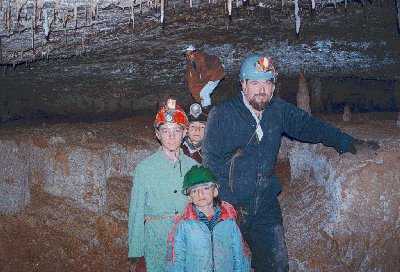

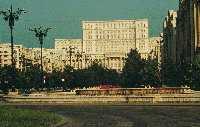 We started out of Bucharest, driving past posters urging the election of
tennis bad boy Ilie Nastase for mayor (he lost). We made a brief stop to
ogle the "House of the People," a huge building (the third-largest in the
world) built by the Communist dictator Ceaucescu as a grand imperial state
house. The cost of building this spectacularly ugly building drove the nation
into near-bankruptcy. Ceaucescu was overthrown and executed shortly after it
was completed, and it is now known as "Casa Nebunului" (Madman's House).
And you think your house is nothing but trouble...
We started out of Bucharest, driving past posters urging the election of
tennis bad boy Ilie Nastase for mayor (he lost). We made a brief stop to
ogle the "House of the People," a huge building (the third-largest in the
world) built by the Communist dictator Ceaucescu as a grand imperial state
house. The cost of building this spectacularly ugly building drove the nation
into near-bankruptcy. Ceaucescu was overthrown and executed shortly after it
was completed, and it is now known as "Casa Nebunului" (Madman's House).
And you think your house is nothing but trouble...
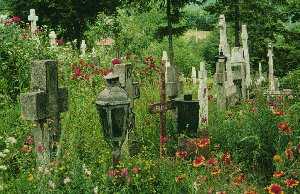 The graveyard at Cozia |
Since, apparently, no American-written story can mention Transylvania
without also mentioning Dracula, it should be noted here that
the monastery was completed mainly due to the patronage of one
Mircea the Old, who was the grandfather of Vlad Tepes (the Impaler),
the 15th century Wallachian (not Transylvanian) ruler on whom
Englishman Bram Stoker later based the character of Dracula, mostly
due to Vlad's passion for impaling his enemies on wooden stakes.
Vlad's father was known as Vlad Dracul (Drac means either "Dragon"
or, more frequently, "Devil," depending on who you ask, and Dracul means "The Devil").
"Dracula" means "Son of the Devil."
Today, Vlad Tepes is actually a revered figure
in Romanian history, remembered as a tough ruler in tough times.
There. I feel better. |
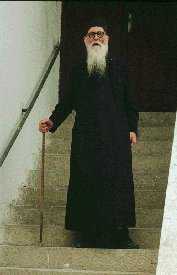 A monk at Cozia |
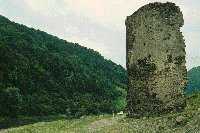 Roman ruin in the Red Tower Pass. |
Further north, and finally into Transylvania, in the Red Tower
Pass, we stopped for our first meal, bread, cheese, and the best tomatoes
I've ever tasted, washed down with carbonated mineral water (the only bottled
water available in Romania) and Coke. Then, we climbed over the ruins of a Roman
fortification overlooking the River Olt, where the Romans used
to make people pay for travelling through the mountain pass.
Next was a brief stop in the medieval city of Sibiu, the birthplace of Dana Moldovan, Genoa's manager of sustaining engineering. This is not your typical Romanian town. In fact, it's German. The original settlers came mainly from the Rhineland, and walking the streets, it's easy to believe you're somewhere near Nuremberg. |
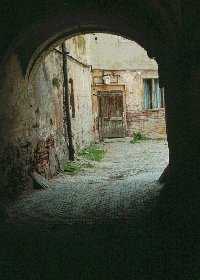 |
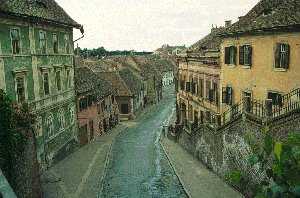 |
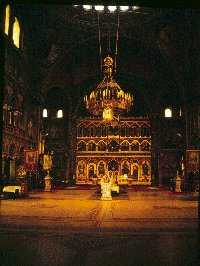 |
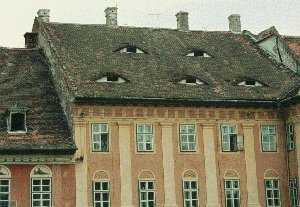 |
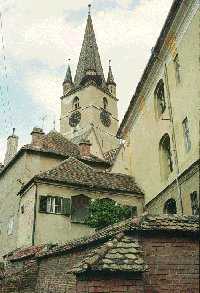 |
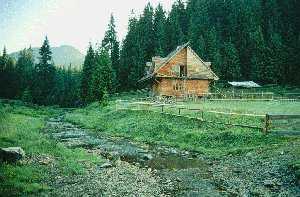 The cabin in the Carpathians. |
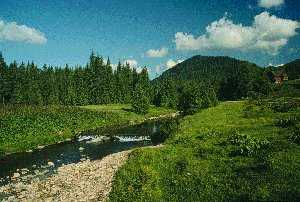 Our front yard. |
A stream flowing out of a cave. 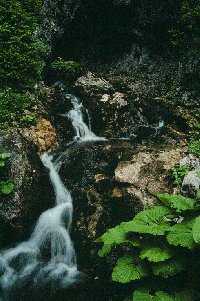 |
That day, Mike announced we would be going on "The Easy Hike," which was, in fact, quite easy...at first. We hiked along the dirt road next to the stream, occasionally stopping in a meadow or somesuch to do some photography. We passed a cave or two, but were told they weren't worth going into. After several hours and untold kilometers, the road got a bit rougher, then turned into more of a trail, then disappeared entirely. The fun was over. It was time to see The Gorge. Not from the bottom, no. From the top, most of a kilometer or so above our heads. 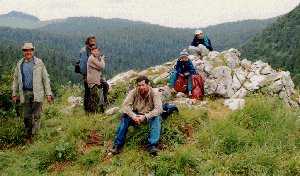 King of the hill. Whoopie. Photo by Mike Moldovan |
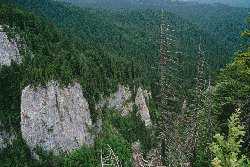 |
I'm not sure which was the more exciting part of that climb, the
muddy, slippery part, or the rocky, "look-out-below"
("Petru! Petru!") part. Predictably, I was bringing
up the rear on that part, so I got the full benefit of the lesson
in Newton's laws of motion. The view from the top was breathtaking...or
maybe it was the climb that did that. Anyway, we soon started
down, which turned out to be almost as fun as going up, except
this time, I was the one sending rocks down on the people below.
Hours later, when we rounded a curve and finally saw the cabin,
it looked considerably cozier to me. Guess the workmen must have
made some good progress during the day... |
A looonnnggg way down.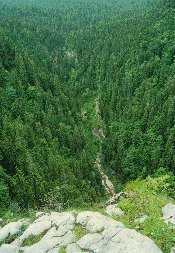 |
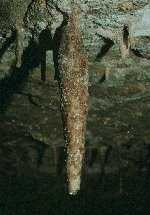
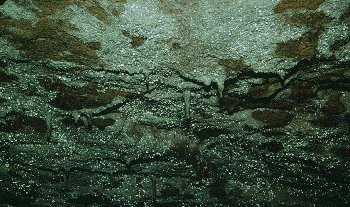 The specks of "silver" are water drops |
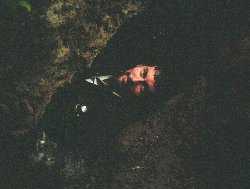 Squeezing out of a hole in the ground Photo by Andrei Lascu |
|
Now, as it turns out, I'm an amateur astronomer, and the stars
are another thing that gets me outdoors, but I consider the stars
for looking at, not sleeping under. Sleeping out in the open was
something I'd never done in my life, and I wasn't really ready
to start practicing right then and there. I was set to sleep in
the car, but somebody had had the foresight to bring a tent. As
I was settling down in my little canvas retreat-from-nature, I
heard one of the Romanians say to Jim, "by the way, if you
feel something slimy against your face, don't move too fast..."
My fondness for my shelter increased further at dawn, when all
the outdoorsy types got rained on. |
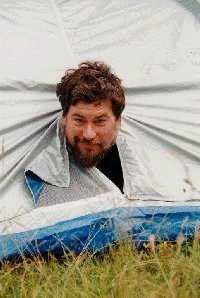 Where's room service with my #@!%$ coffee? Photo by Mike Moldovan. |
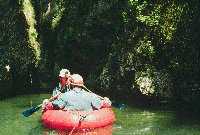 Jim and Christian head into Topolnita cave |
The field was our base camp for a visit to Topolnita cave, which
has a river running through it, and huge entrances on two sides
of the mountain. We first hiked over to the entrance where the
river enters the cave, then over to the opposite side, where we
inflated a couple of rubber boats and paddled upstream into the
other entrance. While we were getting our gear together by the
river, Nicu showed me his latest find: a container full of scorpions. "Oh, yes," he said. "They're all over. Lift any
rock, there they are." I hastily departed the rocks I was
lying on. |
Heading upstream Photo by Mike Moldovan 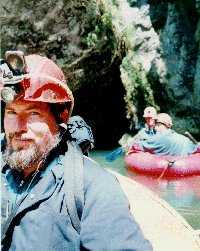 |
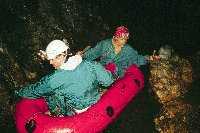 Jim and Christian navigate the rocks |
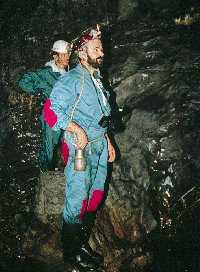 Jim and Mike |
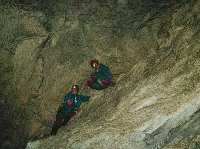 Mike and Christian climbing the walls. |
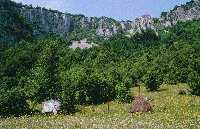 While I'll refrain from the gruesome details, basically it was
a gruelling hike up a very steep slope to the top of a very high
mountain, some wandering around on a picturesque plateau, followed
by an equally gruelling climb down the mountain. It didn't help matters
that we'd run out of water halfway on the trip. Near the end, we finally
found a spring that was safe to drink from.
While I'll refrain from the gruesome details, basically it was
a gruelling hike up a very steep slope to the top of a very high
mountain, some wandering around on a picturesque plateau, followed
by an equally gruelling climb down the mountain. It didn't help matters
that we'd run out of water halfway on the trip. Near the end, we finally
found a spring that was safe to drink from.
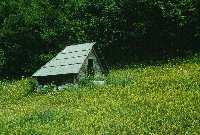 A shepherd's shack. |
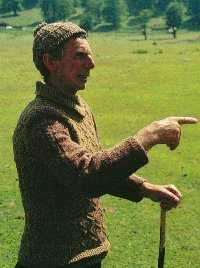 Civilization? Nope, you can't get there from here, young fella. |
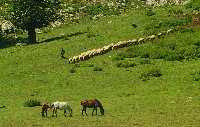
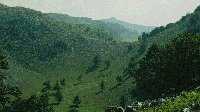 |
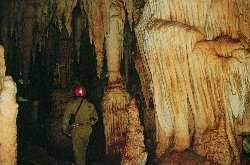 Saturday was our last full day in Romania. When I woke, I was
positively astonished that I could move at all. Apparently, the
previous day's ordeal had left little permanent scarring (although,
as I write this, in August, skin is still peeling off my
feet...but then, that's probably more information than you were
looking for). We gathered up our caving gear and made a hasty trip
to Closani cave, which
was the first real cave Jim and I had seen, and our first chance
to make some interesting photos of cave formations. We even got
a chance to make a "proper" cave photo, where the camera
is fixed on a tripod, the shutter opened, and then various parts
of the cave are "painted" with light. Christian did
the lighting for us, and the results were nothing short of spectacular.
Hmmmm....almost makes me want to take up cave photography....
Saturday was our last full day in Romania. When I woke, I was
positively astonished that I could move at all. Apparently, the
previous day's ordeal had left little permanent scarring (although,
as I write this, in August, skin is still peeling off my
feet...but then, that's probably more information than you were
looking for). We gathered up our caving gear and made a hasty trip
to Closani cave, which
was the first real cave Jim and I had seen, and our first chance
to make some interesting photos of cave formations. We even got
a chance to make a "proper" cave photo, where the camera
is fixed on a tripod, the shutter opened, and then various parts
of the cave are "painted" with light. Christian did
the lighting for us, and the results were nothing short of spectacular.
Hmmmm....almost makes me want to take up cave photography....
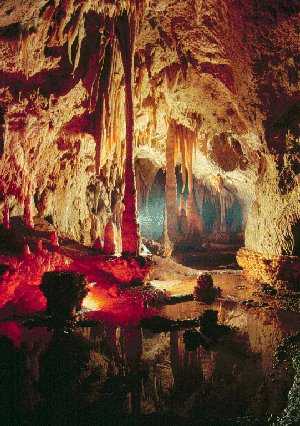 Closani cave Lighting by Christian Lascu |
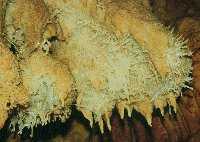
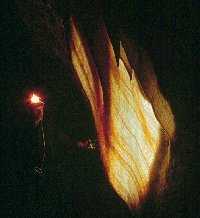 Christian backlights a drapery to show its translucence. |
 Back to my homepage
Back to my homepage